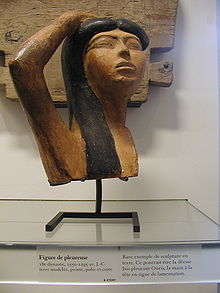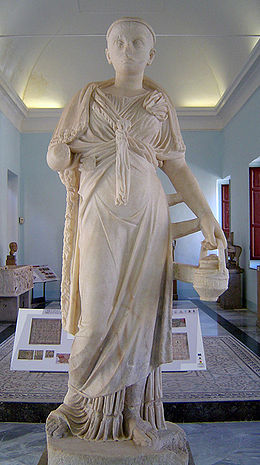- Isis
-
This article discusses the ancient goddess Isis. For other uses, see Isis (disambiguation).
Isis 
The goddess Isis is portrayed as a woman, wearing a headress shaped like a throne; sometimes she is also shown with bird's wings.Goddess of motherhood, magic and fertility Major cult center Philae, Abydos Symbol the throne, the sun disk with cow's horns, the sycamore tree Parents Geb and Nut Siblings Osiris, Set, Horus, and Nephthys Consort Osiris 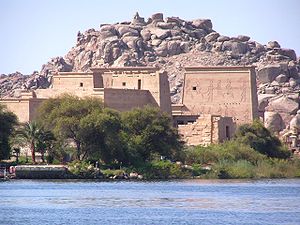 Temple of Isis in Philae, Egypt
Temple of Isis in Philae, Egypt
Isis or in original more likely Aset (Ancient Greek: Ἶσις) is a goddess in Ancient Egyptian religious beliefs, whose worship spread throughout the Greco-Roman world. She was worshipped as the ideal mother and wife as well as the matron of nature and magic. She was the friend of slaves, sinners, artisans, and the downtrodden, and she listened to the prayers of the wealthy, maidens, aristocrats, and rulers.[1] Isis is the goddess of motherhood, magic and fertility.
The goddess Isis (mother of Horus) was the first daughter of Geb, god of the Earth, and Nut, the goddess of the Overarching Sky, and was born on the fourth intercalary day. At some time Isis and Hathor had the same headdress. In later myths about Isis, she had a brother, Osiris, who became her husband, and she then was said to have conceived Horus. Isis was instrumental in the resurrection of Osiris when he was murdered by Set. Her magical skills restored his body to life after she gathered the body parts that had been strewn about the earth by Set.[2] This myth became very important in later Egyptian religious beliefs.
Isis is also known as protector of the dead and goddess of children from whom all beginnings arose. In later times, the ancient Egyptians believed that the Nile River flooded every year because of her tears of sorrow for her dead husband, Osiris. This occurrence of his death and rebirth was relived each year through rituals. The worship of Isis eventually spread throughout the Greco-Roman world, continuing until the suppression of paganism in the Christian era.[3]
Contents
Origin of the name
![Q1 [st] st](/pictures/enwiki/50/250px-%C3%84gyptischer_Maler_um_1360_v._Chr._001.jpg)
![X1 [t] t](/w/extensions/wikihiero/img/hiero_X1.png)


.or ![Q1 [st] st](/w/extensions/wikihiero/img/hiero_Q1.png)
![X1 [t] t](/w/extensions/wikihiero/img/hiero_X1.png)
![Z4 [y] y](/w/extensions/wikihiero/img/hiero_Z4.png)

Isis
in hieroglyphsThe name Isis is an anglicized version of the Greek version of her name, which itself changed the original Egyptian name spelling by the addition of a last -s because of the grammatical requirements of Greek endings.
The Egyptian name was recorded as ỉs.t or ȝs.t and meant "(She of the) Throne". The true Egyptian pronunciation remains uncertain, however, because hieroglyphs do not have vowels. Based on recent studies which present us with approximations based on contemporary languages (specifically, Greek) and Coptic evidence, the reconstructed pronunciation of her name is *Usat [*ˈʔyːsəʔ]. Osiris's name—that is, *Usir "Osiris" (ws-ỉr) also starts with the throne glyph ʔs (-s). The name survived in Coptic dialects as Ēse or Ēsi, as well as in compound words surviving in names of later people such as "Har-si-Ese", which means "Horus, son of Isis".
For convenience, Egyptologists arbitrarily choose to pronounce her name as "ee-set". Sometimes they may also say "ee-sa" because the final "t" in her name was a feminine suffix, which is known to have been dropped in speech during the last stages of the Egyptian language.
The name Isis means "Throne". Her headdress is a throne. As the personification of the throne, she was an important representation of the pharaoh's power, as the pharaoh was depicted as her child, who sat on the throne she provided. Her cult was popular throughout Egypt, but the most important sanctuaries were at Behbeit El-Hagar in the Nile delta, in Lower Egypt and, beginning in the reign with Nectanebo I (380-362 BCE), on the Upper Egyptian island of Philae.
Early history
The Goddess Isis, wall painting, c. 1360 BC
Her origins are uncertain, but are believed to have come from the Nile Delta. Like other Egyptian deities she did have a centralized Cult of Isis (New cults) in the Hellenistic Civilization. First mentions of Isis date back to the Fifth dynasty of Egypt which is when the first literary inscriptions are found, but her cult became prominent late in Egyptian history, when it began to absorb the cults of many other goddesses with strong cult centers. This is when the cult of Osiris arose and she became such an important figure in those beliefs. Her cult eventually spread outside Egypt.
During the formative centuries of Christianity, the religion of Isis drew converts from every corner of the Roman Empire. In Italy itself, the Egyptian faith was a dominant force. At Pompeii, archaeological evidence reveals that Isis played a major role. In Rome, temples were built and obelisks erected in her honour. In Greece, traditional centres of worship in Delos, Delphi, and Eleusis were taken over by followers of Isis, and this occurred in northern Greece and Athens as well. Harbours of Isis were to be found on the Arabian Sea and the Black Sea. Inscriptions show followers in Gaul, Spain, Pannonia, Germany, Arabia, Asia Minor, Portugal and many shrines even in Britain.[4]
Temples
Most Egyptian deities first appeared as very local cults and throughout their history retained those local centres of worship, with most major cities and towns widely known as the home of these deities. Isis originally was an independent and popular deity established in predynastic times, prior to 3100 BC, at Sebennytos in the northern delta.[2]
Eventually temples to Isis began to spread outside of Egypt. In many locations, devotees of Isis considered a number of the local goddesses to be Isis, but under different names. The worship of Isis was joined to that of other Mediterranean goddesses, such as Demeter, Astarte, Aphrodite, and more. During the Hellenic era, due to her attributes as a protector and mother, as well as a lusty aspect gained when she absorbed some aspects of Hathor, she became the patron goddess of sailors, who spread her worship with the trading ships circulating the Mediterranean Sea.
Likewise, the Arabian goddess Al-Ozza or Al-Uzza العُزّى (al ȝozza), whose name is close to that of Isis, is believed to be a manifestation of her. This, however, is thought to be based on the similarity in the name.
Throughout the Graeco-Roman world, Isis became one of the most significant of the mystery religions, and many classical writers refer to her temples, cults, and rites.
Temples to Isis were built in Iraq, Greece and Rome, with a well preserved example discovered in Pompeii. On the Greek island of Delos a Doric Temple of Isis was built on a high over-looking hill at the beginning of the Roman period to venerate the familiar trinity of Isis, the Alexandrian Serapis and Harpocrates. The creation of this temple is significant as Delos is particularly known as the birthplace of the Greek gods Artemis and Apollo who had temples of their own on the island long before the temple to Isis was built. At Philae her worship persisted until the 6th century, long after the rise of Christianity and the subsequent suppression of paganism. The cult of Isis and Osiris continued up until the 6th century AD on the island of Philae in Upper Nile. The Theodosian decree (in about 380 AD) to destroy all pagan temples was not enforced there until the time of Justinian. This toleration was due to an old treaty made between the Blemyes-Nobadae and Diocletian. Every year they visited Elaphantine and at certain intervals took the image of Isis up river to the land of the Blemyes for oracular purposes before returning it. Justinian sent Narses to destroy the sanctuaries, with the priests being arrested and the divine images taken to Constantinople.[5] Philae was the last of the ancient Egyptian temples to be closed.
Priesthood
Little information on Egyptian rituals for Isis survives, however, it is clear there were both priests and priestesses officiating at her cult rituals throughout its entire history. By the Greco-Roman era, many of them were healers, and were said to have many other special powers, including dream interpretation and the ability to control the weather, which they did by braiding or not combing their hair. The latter was believed because the Egyptians considered knots to have magical powers.
Iconography
Associations
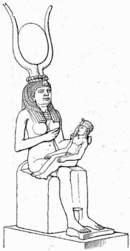
"tyet"
Knot of Isis
in hieroglyphsDue to the association between knots and magical power, a symbol of Isis was the tiet or tyet (meaning welfare/life), also called the Knot of Isis, Buckle of Isis, or the Blood of Isis, which is shown to the right. In many respects the tyet resembles an ankh, except that its arms point downward, and when used as such, seems to represent the idea of eternal life or resurrection. The meaning of Blood of Isis is more obscure, but the tyet often was used as a funerary amulet made of red wood, stone, or glass, so this may simply have been a description of the appearance of the materials used.
The star Sopdet (Sirius) is associated with Isis. The appearance of the star signified the advent of a new year and Isis was likewise considered the goddess of rebirth and reincarnation, and as a protector of the dead. The Book of the Dead outlines a particular ritual that would protect the dead, enabling travel anywhere in the underworld, and most of the titles Isis holds signify her as the goddess of protection of the dead.
Probably due to assimilation with the goddesses Aphrodite and Venus, during the Roman period, the rose was used in her worship. The demand for roses throughout the empire turned rose production into an important industry.
Depictions
Isis nursing Horus, wearing the headdress of Hathor
In art, originally Isis was pictured as a woman wearing a long sheath dress and crowned with the hieroglyphic sign for a throne. Sometimes she was depicted as holding a lotus, or, as a Sycamore tree. One pharaoh, Thutmose III, was depicted in his tomb as nursing from a sycamore tree that had a breast.
After she assimilated many of the roles of Hathor, Isis's headdress is replaced with that of Hathor: the horns of a cow on her head, with the solar disk between them. Sometimes she also was represented as a cow, or a cow's head. Usually, however, she was depicted with her young child, Horus (the pharaoh), with a crown, and a vulture. Occasionally she was represented as a kite flying above the body of Osiris or with the dead Osiris across her lap as she worked her magic to bring him back to life.
Most often Isis is seen holding only the generic ankh sign and a simple staff, but in late images she is seen sometimes with items usually associated only with Hathor, the sacred sistrum rattle and the fertility-bearing menat necklace. In The Book of Coming Forth By Day Isis is depicted standing on the prow of the Solar Bark with her arms outstretched.[1]
Isis in literature
Plutarch, a Greek scholar who lived from 46 AD to 120 AD, wrote Isis and Osiris,[6] which is considered a main source about the very late myths about Isis.[7] In it he writes of Isis, describing her as: "a goddess exceptionally wise and a lover of wisdom, to whom, as her name at least seems to indicate, knowledge and understanding are in the highest degree appropriate..." and that the statue of Athena (Plutarch says "whom they believe to be Isis" in Sais carried the inscription "I am all that has been, and is, and shall be, and my robe no mortal has yet uncovered."[8] At Sais, however, the patron goddess of its ancient cult was Neith, many of whose traits had begun to be attributed to Isis during the Greek occupation. In The Golden Ass the Roman writer Apuleius later gives us his understanding of Isis in the 2nd century, and describes the Navigium Isidis festival. The following paragraph is particularly significant:
You see me here, Lucius, in answer to your prayer. I am nature, the universal Mother, mistress of all the elements, primordial child of time, sovereign of all things spiritual, queen of the dead, queen of the ocean, queen also of the immortals, the single manifestation of all gods and goddesses that are, my nod governs the shining heights of Heavens, the wholesome sea breezes. Though I am worshipped in many aspects, known by countless names ... some know me as Juno, some as Bellona ... the Egyptians who excel in ancient learning and worship call me by my true name...Queen Isis.Mythology
When seen as the deification of the wife of the pharaoh in later myths, the prominent role of Isis was as the assistant to the deceased pharaoh. Thus she gained a funerary association, her name appearing over eighty times in the Pyramid Texts, and she was said to be the mother of the four deities who protected the canopic jars—more specifically, Isis was viewed as protector of the liver-jar-deity, Imsety. This association with the pharaoh's wife also brought the idea that Isis was considered the spouse of Horus (once seen as her child), who was protector, and later the deification of the pharaoh. By the Middle Kingdom, the 11th through 14th dynasties between 2040 and 1640 BC, as the funeral texts began to be used by more members of Egyptian society, other than the royal family, her role also grows to protect the nobles and even the commoners.
By the New Kingdom, the 18th, 19th, and 20th dynasties between 1570 and 1070 BC, Isis gained prominence as the mother and protector of the pharaoh. During this period, she is said to breastfeed the pharaoh and often is depicted doing so.
The role of her name and her throne-crown is uncertain. Some early Egyptologists believed that being the throne-mother was Isis's original function, however, a more modern view states that aspects of that role came later by association. In many African tribes, the throne is known as the mother of the king, and that concept fits well with either theory, possibly giving insight into the thinking of ancient Egyptians.
Sister-wife to Osiris
In the Old Kingdom, the 3rd Dynasty through to the 6th Dynasty dated between 2686 to 2134 BC, the pantheons of individual Egyptian cities varied by region. During the 5th dynasty, Isis became one of the Ennead of the city of Heliopolis. She was believed to be a daughter of Nut and Geb, and sister to Osiris, Nephthys, and Set. The two sisters, Isis and Nephthys, often were depicted on coffins, with wings outstretched, as protectors against evil. As a funerary deity, she was associated with Osiris, lord of the underworld (Duat), and was considered his wife.
Rare terracotta image of Isis lamenting the loss of Osiris (eighteenth dynasty) Musée du Louvre, Paris
A later mythology (ultimately a result of the replacement of another deity, Anubis, of the underworld when the cult of Osiris gained more authority), tells us of the birth of Anubis. The tale describes how Nephthys was denied a child by Set and disguised herself as the much more attractive Isis to seduce him. The plot failed, but Osiris now found Nephthys very attractive, as he thought she was Isis. They coupled, resulting in the birth of Anubis. Alternatively, Nephthys had intentionally assumed the form of Isis in order to trick Osiris into fathering her son. In fear of Set's retribution upon them, Nephthys persuaded Isis to adopt Anubis, so that Set would not find out and kill the child. The tale describes both why Anubis is seen as an underworld deity (he becomes a son of Osiris), and why he could not inherit Osiris's position (he was not a legitimate heir in this new birth scenario), neatly preserving Osiris's position as lord of the underworld. It should be remembered, however, that this new myth was only a later creation of the Osirian cult who wanted to depict Set in an evil position, as the enemy of Osiris.
In another Osirian myth, Set had a banquet for Osiris in which he brought in a beautiful box and said that whoever could fit in the box perfectly would get to keep it. Set had measured Osiris in his sleep and made sure that he was the only one who could fit the box. Several tried to see whether they fit. Once it was Osiris's turn to see if he could fit in the box, Set closed the lid on him so that the box was now a coffin for Osiris. Set flung the box in the Nile so that it would drift far away. Isis went looking for the box so that Osiris could have a proper burial. She found the box in a tree in Byblos, a city along the Phoenician coast, and brought it back to Egypt, hiding it in a swamp. But Set went hunting that night and found the box. Enraged, Set chopped Osiris's body into fourteen pieces and scattered them all over Egypt to ensure that Isis could never find Osiris again for a proper burial.[9][10] Isis and her sister Nephthys went looking for these pieces, but could only find thirteen of the fourteen. Fish had swallowed the last piece, his phallus, so Isis made him a new one with magic, putting his body back together after which they conceived Horus. The number of pieces is described on temple walls variously as fourteen and sixteen, and occasionally forty-two, one for each nome or district.[10]
Assimilation of Hathor
When the cult of Ra rose to prominence he became associated with the similar deity, Horus. Hathor had been paired with Ra in some regions and when Isis began to be paired with Ra, soon Hathor and Isis began to be merged in some regions also as, Isis-Hathor.
Mother of Horus
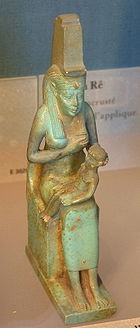 Isis nursing Horus, (Louvre)
Isis nursing Horus, (Louvre)
By merging with Hathor, Isis became the mother of Horus, rather than his wife, and thus, when beliefs of Ra absorbed Atum into Atum-Ra, it also had to be taken into account that Isis was one of the Ennead, as the wife of Osiris. It had to be explained how Osiris, however, who (as lord of the dead) being dead, could be considered a father to Horus, who was not considered dead. This conflict in themes led to the evolution of the idea that Osiris needed to be resurrected, and therefore, to the Legend of Osiris and Isis, of which Plutarch's Greek description written in the 1st century AD, De Iside et Osiride, contains the most extensive account known today.[7]
Yet another set of late myths detail the adventures of Isis after the birth of Osiris's posthumous son, Horus. Isis was said to have given birth to Horus at Khemmis, thought to be located on the Nile Delta.[11] Many dangers faced Horus after birth, and Isis fled with the newborn to escape the wrath of Set, the murderer of her husband. In one instance, Isis heals Horus from a lethal scorpion sting; she also performs other miracles in relation to the cippi, or the plaques of Horus. Isis protected and raised Horus until he was old enough to face Set, and subsequently, became the pharaoh of Egypt.
Magic
In order to resurrect Osiris for the purpose of having the child Horus, it was necessary for Isis to "learn" magic[citation needed] (which long had been her domain before the cult of Ra arose), and so it was said that Isis tricked Ra (i.e. Amun-Ra/Atum-Ra) into telling her his "secret name," by causing a snake to bite him, for which only Isis had the cure. The names of deities were secret and not divulged to any but the religious leaders. Knowing the secret name of a deity enabled one to have power of the deity. That he would use his "secret name" to "survive" implies that the serpent had to be a more powerful deity than Ra. The oldest deity known in Egypt was Wadjet, the Egyptian cobra, whose cult never was eclipsed in Ancient Egyptian religion. As a deity from the same region, she would have been a benevolent resource for Isis. The use of secret names became central in late Egyptian magic spells, and Isis often is implored to "use the true name of Ra" in the performance of rituals. By the late Egyptian historical period, after the occupations by the Greeks and the Romans, Isis became the most important and most powerful deity of the Egyptian pantheon because of her magical skills. Magic is central to the entire mythology of Isis, arguably more so than any other Egyptian deity.
Prior to this late change in the nature of Egyptian religion, the rule of Ma'at had governed the correct actions for most of the thousands of years of Egyptian religion, with little need for magic. Thoth had been the deity who resorted to magic when it was needed. The goddess which held the quadruple roles of healer, protector of the canopic jars, protector of marriage, and goddess of magic previously had been Serket. She then became considered an aspect of Isis. Thus it is not surprising that Isis had a central role in Egyptian magic spells and ritual, especially those of protection and healing. In many spells, she also is completely merged even with Horus, where invocations of Isis are supposed to involve Horus's powers automatically as well. In Egyptian history the image of a wounded Horus became a standard feature of Isis's healing spells, which typically invoked the curative powers of the milk of Isis. (Silverman, Ancient Egypt, 135)
By nation
In Egypt
Isis was venerated first in Egypt. Isis was the only goddess worshiped by all Egyptians alike,[12] and whose influence was so widespread that she had become completely syncretic with the Greek goddess Demeter.[13] After the conquest of Egypt by Alexander the Great, and the Hellenization of the Egyptian culture initiated by Ptolemy I Soter, Isis eventually became known as Queen of Heaven.[14]
Greco-Roman world
Following the conquest of Egypt by Alexander the Great the worship of Isis spread throughout the Graeco-Roman world.[15] Tacitus writes that after Julius Caesar's assassination, a temple in honour of Isis had been decreed; Augustus suspended this, and tried to turn Romans back to the Roman deities who were closely associated with the state. Eventually the Roman emperor Caligula abandoned the Augustan wariness toward what was described as oriental cults, and it was in his reign that the Isiac festival of the Navigium Isidis was established in Rome. According to Josephus, Caligula donned female garb and took part in the mysteries he instituted, and in the Hellenistic age Isis acquired a "new rank as a leading goddess of the Mediterranean world." Vespasian, along with Titus, practised incubation in the Roman Iseum. Domitian built another Iseum along with a Serapeum. Trajan appears before Isis and Horus, presenting them with votive offerings of wine, in a bas-relief on his triumphal arch in Rome.[16] Hadrian decorated his villa at Tibur with Isiac scenes. Galerius regarded Isis as his protectress.[17]
Roman perspectives on cults were syncretic, seeing in new deities, merely local aspects of a familiar one. For many Romans, Egyptian Isis was an aspect of Phrygian Cybele, whose orgiastic rites were long-naturalized at Rome, indeed, she was known as Isis of Ten Thousand Names.
Among these names of Roman Isis, Queen of Heaven is outstanding for its long and continuous history. Herodotus identified Isis with the Greek and Roman goddesses of agriculture, Demeter and Ceres.
In later years, Isis also had temples throughout Europe, Africa and Asia. An alabaster statue of Isis from the 3rd century BC, found in Ohrid, in the Republic of Macedonia, is depicted on the obverse of the Macedonian 10 denars banknote, issued in 1996.[18]
The male first name "Isidore" (also "Isador"), means in Greek "Gift of Isis" (similar to "Theodore", "God's Gift"). The name, which became common in Roman times, survived the suppression of the Isis worship and remains popular up to the present - being among others the name of several Christian saints.
Kenya
Among the Kalenjins tribe of Kenya East Africa, the god name Asis is used to depict the god sun which according to historian Kipkoech Sambu is the same god Isis. [19]
Titles
In the Book of the Dead Isis was described as:
- She who gives birth to heaven and earth,
- She who knows the orphan,
- She who knows the widow spider,
- She who seeks justice for the poor people,
- She who seeks shelter for the weak people
- She who seeks the righteousness in her people
Some of Isis's many other titles were:
- Queen of Heaven,
- Mother of the Gods,
- The One Who is All,
- Lady of Green Crops,
- The Brilliant One in the Sky,
- Star of the Sea,[20]
- Great Lady of Magic,
- Mistress of the House of Life,
- She Who Knows How To Make Right Use of the Heart,
- Light-Giver of Heaven,
- Lady of the Words of Power,
- Moon Shining Over the Sea.
See also
- "Isis" of the Suebi, a goddess identified by Tacitus as venerated by the Suebi, a Germanic people
Notes
- ^ a b R.E Witt, Isis in the Ancient World, p. 7, 1997, ISBN 0-8018-5642-6
- ^ a b Veronica Ions, Egyptian Mythology, Paul Hamlyn, 1968, ISBN 0-600-02365-6
- ^ Henry Chadwick, The Church in Ancient Society: From Galilee to Gregory the Great, Oxford University Press, 2003, p. 526, ISBN 0-19-926577-1
- ^ R.E Witt, Isis in the Ancient World, 1997, ISBN 0-8018-5642-6
- ^ John Bagnell Bury, "History of the Later Roman Empire from the Death of Theodosius I. to the Death of Justinian", The Suppression of Paganism, ch22, p. 371, Courier Dover Publications, 1958, ISBN 0-486-20399-9
- ^ "Plutarch: Isis and Osiris". Loeb Classical Library.
- ^ a b D.S. Richter, "Plutarch On Isis and Osiris: Text, Cult, and Cultural Appropriation", Transactions of the American Philological Association (2001) 131:191–216
- ^ Plutarch, translated by Frank Cole Babbitt, Isis and Osiris, 1936, vol. 5 Loeb Classical Library
- ^ Mercantante, Anthony S. Who's What in Egyptian Mythology MetroBooks (NY); 2nd edition (March 2002) ISBN 978-1-58663-611-1 p.114
- ^ a b Pinch, Geraldine Handbook of Egyptian Mythology ABC-CLIO Ltd; 31 Aug 2002 ISBN 978-1-57607-242-4 p. 79 [1]
- ^ Griffiths, J. Gwyn. (2002). "Isis". In D. B. Redford (Ed.), The ancient gods speak: A guide to Egyptian religion. p. 169. New York: Oxford University Press.
- ^ Herodotus (5th century BCE). Histories. 2.42
- ^ Herodotus (5th century BCE). Histories. 2.156
- ^ R.E Witt, Isis in the Ancient World, 1997, ISBN 0801856426
- ^ R.E Witt, Isis in the Ancient World, 1997, ISBN 0-8018-5642-6
- ^ R.E Witt, Isis in the Ancient World, Ch17: "The Goddess Darling of the Roman Emperors", p. 235, 1997, ISBN 0-8018-5642-6
- ^ R.E Witt, Isis in the Ancient World, p.51, 1997, ISBN 0-8018-5642-6
- ^ National Bank of the Republic of Macedonia. Macedonian currency. Banknotes in circulation: 10 Denars. – Retrieved on 30 March 2009.
- ^ Kagoech/The Origin The Keiyo People
- ^ Sandra Billington; Miranda Green. The Concept of the Goddess. Routledge, 1999, p. 70, ISBN 0-415-19789-9
References
Primary sources
- Ovid, Metamorphoses i.588–747
- Eusebius, Chronicon 32.9–13, 40.7–9, 43.12–16
Secondary sources
- Ian Shaw (2000) The Oxford History of Ancient Egypt
- Rosalie David (1998) Handbook to Life in Ancient Egypt
- Lewis Spences (1990) Ancient Egyptian Myths and Legends
- Plutarch, (1936) De Iside et Osiride, edited by Frank C. Babbitt
- Richard H. Wilkinson (2003) The Complete Gods and Goddesses of Ancient Egypt
- Ian Shaw & Paul T. Nicholson (1995) The British Museum Dictionary of Ancient Egypt
- Kockelmann, Holger, Praising the goddess: a comparative and annotated re-edition of six demotic hymns and praises addressed to Isis (Berlin; New York: Walter de Gruyter, 2008).
Ancient Egyptian religion Mythology 


Deities Amun · Amunet · Anubis · Anuket · Apep · Apis · Aten · Atum · Bastet · Bat · Bes
Four sons of Horus · Geb · Hapi · Hathor · Heka · Heqet · Horus · Isis · Khepri
Khnum · Khonsu · Kuk · Maahes · Ma'at · Mafdet · Menhit · Meretseger · Meskhenet
Monthu · Min · Mnewer · Mut · Neith · Nekhbet · Nefertem · Nephthys · Nu · Nut · Osiris
Pakhet · Ptah · Qebui · Ra · Reshep · Satet · Sekhmet · Seker · Serket · Sobek
Sopdet · Sopdu · Set · Seshat · Shu · Taweret · Tefnut · Tatenen · Thoth · Wadjet
Wadj-wer · Wepwawet · WosretWritings Beliefs  Ancient Egypt PortalCategories:
Ancient Egypt PortalCategories:- Egyptian goddesses
- Fertility goddesses
- Agricultural goddesses
- Life-death-rebirth goddesses
- Magic goddesses
- Mother goddesses
- Mystery religions
- Hellenistic Egyptian deities
Wikimedia Foundation. 2010.


